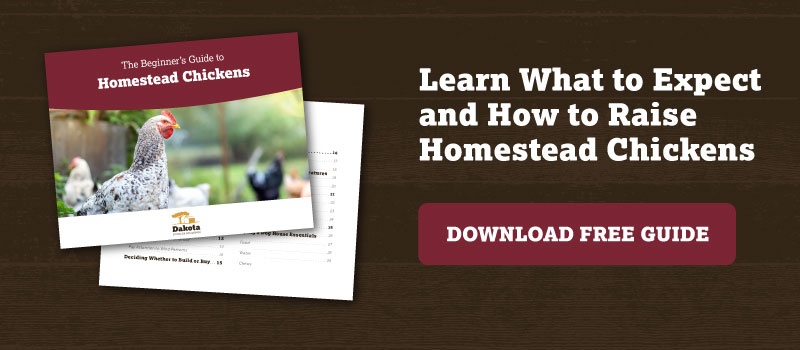4 Things to Know Before Buying Chickens for Your Homestead
by Dakota Storage Buildings, on March 08, 2022
Before buying chickens, consider the law, your goals, the best breed type, and available space.
Buying and raising homestead chickens seems pretty straightforward – and it is, but there are some things about chickens that you should know before jumping into ownership. Here are a few.
![]()
1. Does your city/town or HOA allow poultry?
To ensure chickens are permitted and learn about possible restrictions in your area, contact your local government officials. You can begin the discussion by calling a member of your local planning board, county clerk, or animal control representative. Contact information for the correct person can typically be located on your city's website.
If your county or city does not explicitly prohibit keeping chickens in some way, then you are allowed to keep them as long as you follow all other laws — especially those on noise and sanitation.
2. What’s your goal?
After you know whether it’s legal or not to own chickens where you live, the next step is to identify your goal(s) for raising them — eggs, meat, or both? Your goals will directly impact breed choice, the number of chickens you need, whether or not you need a rooster, and the space requirement.
Regardless of your goals(s), there are two general rules of thumb: never have less than three chickens, and you don’t need a rooster if you don’t want baby chickens. If you do, you'll need one rooster for every five hens.
Eggs & Meat: While most breeds are better for one over the other, there are good dual-purpose chickens like Delaware Broilers, Plymouth Rocks (aka Barred Rock), and Wyandottes.
Eggs Only: If you want eggs, pick a breed known for its high production volume. You may also want to consider adding a breed to your flock that is known to lay in winter months when the others slow down production. If you care about egg color or plan to sell some of your eggs, you may want a breed known for a specific color egg — even though they are all the same on the inside, some egg colors sell better than others.
Keep in mind, if you’re buying chickens for eggs, expect them to lay eggs for a couple of years but live up to ten years.
Meat Only: Meat breeds, or broiler chickens, tend to grow and mature faster than egg-layers and can be female or male. While female broilers can produce eggs, they can only lay about half of what layers do. Also, raising broilers is slightly different from egg layers. For instance, broilers should maintain a high-protein feed to ensure high-quality meat (richer in fat and protein). Also, they are ready for consumption when they reach between 8 and 12 weeks old.
3. How many chickens do you need for what you want?
The number of chickens you need depends on your goal(s). You’ll need less for eggs and more for meat.
Eggs: The average good egg layer will produce roughly five eggs per week and slow down production during the winter. Add a breed that lays during the cold months if you want eggs all year long. Also, plan on adding to your flock every couple of years so that egg production doesn’t slow down.
If the average egg layer lays five eggs a week and your family eats a dozen eggs a week, you will want the minimum amount of recommended chickens (3). If you want more than that per person and some to sell, it’s best to have at least 12-15 chickens.
Meat: How many chickens do you need for meat? You'll need to do a little math to figure that out. Determine your desired consumption (once/week or more), how long it takes to raise and prepare chickens for eating, and whether you plan to freeze the meat or eat it fresh. To make this decision, it's important to know that it takes about 8-12 weeks to raise broilers to maturity and that usually, between 18-36 chickens yield about two butcher-ready chickens per week.
4. Do you have enough space per bird?
If you’re raising chicks, you’ll need two specific spaces: a brooder house and a coop.
A brooder is housing you will use for baby chicks until they are old enough to move into the coop. You’ll need a place in your home or on your property that is free from drafts and elements for 6-10 weeks. With baby chicks, you will need a minimum of 6″ per chick in the Brooder. As they get bigger, they will need 1 square foot per chick.
When it's time for a coop, you'll need to decide if you want free-range chickens or not. In both cases, you still need a coop to protect your flock from harsh elements and predators and to provide a safe place for egg-laying. Allow 3-5 square feet of floor space in your coop for each chicken, 8" of roosting bar per chicken, and one nesting box for every 3-4 hens in which to lay their eggs.
A rule of thumb for free-range space is 250-300 square feet per bird. If you plan to create permanent runs and fencing, use 250 square feet per bird or more. Or, if you plan to buy a coop with a built-in run, aim for ten square feet of run space per chicken. For example, a 5'x6' run will accommodate three chickens and 6'x10' for six.
Conclusion
While this article focuses on the first step of buying chickens for your homestead, keep in mind they offer more benefits than eggs or meat. They provide fertilizer and pest control, plus they can be a source of extra cash and hours of entertainment. Homestead chickens are a great way to put you closer to sustainable living.
More reading:
- Which Type of Backyard Chicken Coop is Right for You?
- What to Know Before Buying and Raising Backyard Chickens
- Should You Buy or DIY Your First Backyard Chicken Coop?
- 6 Features Every Homestead Chicken Coop Should Have
- The Beginners Guide to Homestead Chickens [Download]
- Explore Our Chicken Coops
- More chicken-related articles
Our mission is to help you organize your life and keep your valued possessions safe — that includes your backyard chickens. We know chickens are an investment, and we want to help you keep them secure and happy. We are proud to serve North Dakota, South Dakota, Minnesota, western Wisconsin, northeast Nebraska, and north-central Iowa.



























